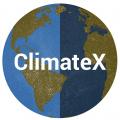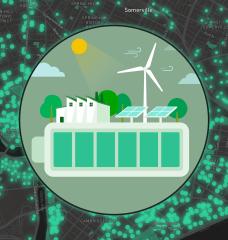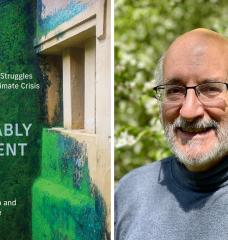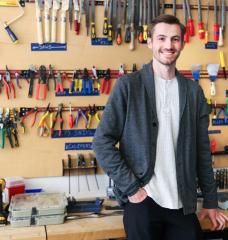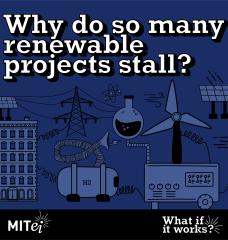Description
This week, we’re joined by Mike Wilson, graduate student at MIT’s Department of Urban Studies and Planning.
We discuss transformative adaptation, and how planners can develop green infrastructures whilst improving the lives of everyone in our global society.
Mike explains how future planning in Boston needs to communicate with local communities to discover their lived experiences, and use these to inform future plans.
If you’re enjoying our Climate Conversations podcast, you can subscribe on your favorite podcast platform to hear the latest episodes first. Find us on:
Transcript
[00:00:00:07] MIKE WILSON: Before we dive in into plan-making, we should talk to the communities first. We've identified some of the challenges. We've identified what the future may look like. Let's go out and talk to Charlestown, and let's go out and talk to East Boston and see what they want, how they may benefit, and then start to hear right from the communities, well, what's your on-the-ground experience? What would you want to see in your city?
[00:00:25:00] RAJESH KASTURIRANGAN: This is "Climate Conversations," a podcast by ClimateX, the online community building a movement to solve our climate crisis.
[00:00:32:25] [MUSIC PLAYING]
[00:00:39:04] Welcome to "Climate Conversations." I am Rajesh Kasturirangan, and today I'm going to be flying solo with Mike Wilson, a graduate student in DUSP-- the Department of Urban Studies and Planning here at MIT. We're going to be talking all about how urban planning and climate change intersect with each other. So Mike, I believe you study planning, and I always wanted to ask a planner, what is planning?
[00:01:07:09] MIKE WILSON: It's a very good question planners ask themselves a lot. Yeah, I was-- my previous graduate degree was in landscape architecture, so I came at planning from a design side and very quickly found that planners come from all different fields. You may have an economics background, a social justice background. You may be interested in real estate development. All of those people can fit into what planning is.
[00:01:34:22] In terms of the direction that planning is heading in, it has a very long and storied history. And some of the things that planning has done over the years, we've taken a lot of time to reflect back on and we've learned from our own actions. And moving forward, I think a lot of planning is about community engagement. It's helping people in communities and neighborhoods visualize and realize what they want their lives to be in the medium- to long-term future.
[00:02:04:05] RAJESH KASTURIRANGAN: That's interesting you say that because I grew up with planning being something that nation states do, because India had a planning commission, and every five years, we used to have this massive national plan, which was never successful. But the idea was to put something out there that the nation would accomplish in the five years. And what's the relationship between that history of planning and what you are mentioning now, looking back and saying maybe the planner's view of the world is a little different from what it used to be?
[00:02:41:07] MIKE WILSON: Yeah, that's actually a great point. My brain, when you said planning, went immediately to city planning as opposed to state planning, and that gets at how planning is quite a big tent. Yeah, state-led, state-level planning is a huge part of the history of planning, and it's not something that I have personally engaged with as much. But yes, there's-- the levels of success that that has achieved have been remarkable progress, but also at a remarkable expense as well, which is on a much smaller scale what we've seen with our cities.
[00:03:21:18] RAJESH KASTURIRANGAN: So tell us what city planning is like these days.
[00:03:25:23] MIKE WILSON: City planning is a very exciting field. And I think, given some of the cycles of history, we're back at what some people would call an urban moment. The city is seen as being ascendant, at least for some, again, and that there's a lot of economic progress and prosperity that can be enacted in cities these days.
[00:03:48:13] In terms of what planning can offer, we can offer a lot of historical perspective, but also the tools about how to think about the future, and that those are really important as people who may have not been residents of cities before, as these cities are rapidly changing to be things that nobody has ever seen before. We have mega-cities that are propping up around the globe. We have cities that have reached the point of being unmanageable right here within the US using traditional political structures. Planning is really having to be as innovative as any other field.
[00:04:24:23] RAJESH KASTURIRANGAN: And you mentioned about the urban moment, but already, I'm also hearing counter voices, right? So something that comes to mind is Richard Florida's famous "the creative class," which he seems to now backing away from himself. So what is this urban moment? And I'm guessing you are working in the Boston area because you're a member of the Boston Conservation Commission. What does the urban moment here look like too?
[00:04:53:25] MIKE WILSON: Yeah, no, and I think here, you're capturing a lot of planning intellectuals. There's a very heavy pendulum swing that happens. And as soon as you have enough data points to identify a trend, pretty soon that trend is now swinging in the other direction. And the forces that we're looking at or we comment upon are generally beyond our control. And if you have any sort of positive reinforcement to them, they can very quickly spiral to something that was very different than what you necessarily may have been talking about to begin with.
[00:05:28:16] I think one of the things that is quoted in the mass public media is the rapid rate of urbanization around the world. And I think part of it, yes, is that traditionally, we have been agrarian. We have been farming-based societies. Mechanization, industrialization has allowed us to become detached from the land. There's questions of what that means and who controls that land.
[00:05:51:24] But as people move to the city or as cities become bigger or more dense, these are very old, ancient problems. How do people get together and live beneficially in small corridors? How do we have private, individual interests work in harmony with a collective public good as well? And those are very well-worn but difficult problems to solve that require a lot of dialog and communication.
[00:06:22:14] RAJESH KASTURIRANGAN: And how does climate change impact on those tensions?
[00:06:27:18] MIKE WILSON: If nothing else, it basically just adds fuel to the fire on a lot of these things. It also gives a chance to have a new reason to revisit things from a different perspective. There's a movement right now afoot in terms of transformative adaptation rather than just regular climate adaptation that isn't just about building--
[00:06:51:01] [INTERPOSING VOICES]
[00:06:51:21] RAJESH KASTURIRANGAN: Sorry. So transformative adaptation is a term of use.
[00:06:54:27] MIKE WILSON: Yes. Yeah, it's a term of use I-- it's I guess probably relatively recent, but the concept being that we need to think more beyond just gray infrastructure-- seawalls, raising buildings, protecting infrastructure to things that are termed green or blue, soft infrastructure. And as a part of that, this is an opportunity. If we're making huge investments in our future in terms of what type of risks or losses we want to avoid, why don't we use that money now to make societal benefits in the [? presence ?] that we can accrue over time? And at the same time, there are a number of social injustices and poverty, inequality, and other things that exist due to the way our institutions have been run, both domestically and internationally-- that this is a chance and something we should do to improve the lives of people and communities that may have otherwise suffered at the hands of business as usual.
[00:08:03:08] RAJESH KASTURIRANGAN: I like that term-- "transformative adaptation."
[00:08:05:13] MIKE WILSON: Yeah, that's exciting.
[00:08:07:08] RAJESH KASTURIRANGAN: So tell us how transformative adaptation plays into your own understanding of the future of planning.
[00:08:13:26] MIKE WILSON: Sure. Yeah, I think it is about transforming institutions and the way they-- the tools that are available within that world can be supplemented by other tools. And it also expands the debate to not what can we do or what do we want to do, but what we should do. And that makes for a more open-ended discussion about what the future may look like beyond just what the past has been.
[00:08:39:27] RAJESH KASTURIRANGAN: So can you give us an example, especially in the Boston area, of a transformatively adapted project or some place where this vision has become at least semi-reality?
[00:08:51:25] MIKE WILSON: In terms of plans, I think that that's where we see a lot of maybe not the rhetoric just yet and the Imagine Boston 2030 in terms of the mayor's healthy, thriving, and innovative forward projection of what the city will look like in 2030. But certainly, Climate Ready Boston, as it looks towards-- it didn't try to set forth what the vision will be from City Hall. It immediately said that these are some of the tools that we're looking at, that this is going-- resilience building is a broad-based social, economic, and physical phenomenon, and that before we dive in into plan-making, we should talk to the communities first.
[00:09:38:13] We've identified some of the challenges. We've identified what the future may look like. Let's go out and talk to Charlestown, and let's go out and talk to East Boston and see what they want, how they may benefit, and present them with some of the information experts have driven, and then start to hear right back from the communities, well, what's your on-the-ground lived experience? What would you want to see in your city? And that then drives some of the scale of thinking that's going on.
[00:10:07:28] RAJESH KASTURIRANGAN: So what are the kind of stories you are hearing in these exercises?
[00:10:11:22] MIKE WILSON: One of the things, especially with, say, Neighborhood of Affordable Housing-- NOAH-- that's been doing a lot of work there has been hearing is that the scale of what residents are thinking of is both very individual but also very collective, where they're concerned about if there is some sort of extreme rain water event or a storm surge event, the streets are flooded, that means their basements are flooded. If their basements are flooded-- they store a lot of stuff down there that's really important to them. Their memories, what they are as a family can be in the basement.
[00:10:45:23] And so helping people categorize what's in your basement, getting it out of the basement-- those small things can build up to a lot of resilience in these communities. But that then also brings them to reflect upon, well, what's important about living in this place? What is special about being in this community? And that may not necessarily be what a planner from City Hall or even the halls of MIT may think is important. And so investing in community spaces and thinking about how do residents of public housing or assisted living projects-- how do they interface with new residents that are coming in and new construction, without changing necessarily the traditional neighborhood feel?
[00:11:32:18] RAJESH KASTURIRANGAN: So I can see so many moving parts in this system, right? There are, you could say, more technology-like parts, and there are more political parts. And how do you-- and I know that you have a background at Harvard, which has a more of a say, natural science to it. And you are now at DUSP, and you are engaging with these planning practices. How do you fit all of this into at least a semi-coherent view of the world?
[00:12:07:22] [CHUCKLING]
[00:12:10:10] MIKE WILSON: I would say coming from my environmental science and public policy background at Harvard that I move very quickly from a mitigation, what can we do now to offset future harm mindset to future harm is already here, and we need to act now to bend the curve on adaptation, and we'll still be too late. So that was a very big pivot, and that moves you very quickly from the natural sciences over to the social sciences. As I began to explore that with my master's thesis, I found also very quickly that once you pull on that thread, it gets very messy and very tangled.
[00:12:51:25] So thinking about adaptation options for say, Boston Harbor, I started looking at the Charles River Dam. And the Charles River Dam was built in the '70s in response to a hurricane that came in the '50s. So already, you can see that planning and engineering financing lag.
[00:13:12:00] When it was not even yet complete, the blizzard of '78 hit, and it came within 40 centimeters of over-topping. And no matter what climate projection you believe in, the likelihood that at some point in the future there will be 40 centimeters of sea level rise is very probable. And the idea that the blizzard of '78, even if it is an extraordinary event, could happen again is also probable. So at some point, the Charles River Dam ceases to provide the protection and function that it was designed to give to Back Bay, Cambridge, and the basin up river.
[00:13:48:25] But we live in Boston. There is no dry land to tie into that's higher than the Charles River Dam for many miles to go around, and it's only protecting a very small part of the city. So OK, let's move the barrier or dam, some sort of engineered solution, further out. OK, well, how are you going to pay for that? What else do you need to attend to that infrastructure behind this wall you have now built? Where is the right place for that?
[00:14:15:22] And then, hold on. That's not protecting everything we think it should, and it's not going to last for as long as we need it to, so what if we may put it further out? And these are some of the things that academics, especially at University of Massachusetts in Boston, are looking at.
[00:14:31:28] RAJESH KASTURIRANGAN: Very interesting.
[00:14:33:05] MIKE WILSON: Yeah, and I think this is the thing where you start to pull on the thread and it gets very messy, and that's where we start to need to look at, well, what's an institutional response? Because an engineering response is going to only double down on the problem and get us into this complex systems failure.
[00:14:52:27] RAJESH KASTURIRANGAN: Can you speak a little bit-- because I know you mentioned on another occasion that when planning works, you don't know that it's working, right? In fact, it's in the background. So how do we bring the importance of planning into the foreground?
[00:15:12:28] MIKE WILSON: So I think one of the things that we're starting to see and that-- you can't attribute it to climate change necessarily, but I think maybe I can attribute it to greater awareness about climate change being out there and thinking more about what constitutes a disaster or some sort of catastrophic event, and that not all of these storms have names.
[00:15:38:04] Not all of these things are storms. We are naturally drawn to say, a Hurricane Katrina or a Sandy or a Maria now, and we can point to how this one event stochastically affected the community. And that's a shock that was delivered to its system, but what it's revealing, really, is long-term stresses that are underneath.
[00:16:05:26] OK, so there's those named storms, but what about the flooding that's in Baton Rouge? All of a sudden, a weather system just parks over top of your city and delivers a deluge. And I think that's where as we start to see more of those types of events, or at least our attention is drawn to those types of events that have always been occurring and we're giving a different type of attention, that's where planning in terms of bending the trend is very important-- that those long-term stresses are what's being revealed.
[00:16:37:03] It's not necessarily that it poured Biblical amounts of rain. It's that the people who are living there didn't have great access to transportation to begin with. They didn't have a fantastic power infrastructure. They had had chronic levels of under-investment and maintenance had been deferred on critical infrastructure systems, and that these people may not have necessarily a safety net to fall back on, and that these people could be us, that this could happen anywhere in any of our communities to people of any means, and that this is incredibly disruptive and doesn't necessarily need to be a catastrophic one-off event. But this is a new normal that may happen, and that that is incredibly difficult and challenging for society to deal with.
[00:17:26:24] RAJESH KASTURIRANGAN: Yeah. We want to ask our listeners, and ideally, they want to ask us, how do I get involved in this? What are the kinds of things that people can get involved in which would be of importance to planners? So for example, there's a huge movement now towards citizen science, but is there an analogous thing that citizens can do in the planning world?
[00:17:53:17] MIKE WILSON: I think one of the things that's tough with getting involved, and especially in something as wide-reaching in its consequences as climate change, is that not everything looks like climate change, and it often doesn't even have the label climate change for fear of provoking a negative reaction among some people and be more widely applicable.
[00:18:18:11] So you have things like, say, the gas tax, that we should index that to inflation, and that was one of the things that was on a state ballot initiative. Is it linked to climate change? Sort of. Maybe. Yes. If gas costs, more people buy less gas. Therefore, there's less pollution. If there is more money in the coffers to improve the roads and transit systems, then that will also bend the curve on emissions, reductions, and stuff like that.
[00:18:47:02] But that comes at a personal cost, and each time if you're faced with these discrete decisions about should I do something about climate change today that costs me now, I think that's where it's like at some point, you have to say, actually, yeah, and it's already costed me because I didn't invest or take action earlier. And that's true with a lot of things. That's the same thing with public education systems or security and the current opioid crisis.
[00:19:22:25] These are long-term issues that require involvement, and at any given moment, it doesn't seem like that will be the thing that's like, oh, I need to stand up and vote. I need to make my voice be heard. Those moments are very rare, and those are important too, where it's like there is a march or a rally going on on Boston Common on this day, and the weather's great. Go out there with your sign. That's important, but it's also every other day, or it's when it comes time to vote, that you need to be present and accounted for.
[00:19:56:00] RAJESH KASTURIRANGAN: Yeah. You need to be able to think through what the costs and benefits are of these actions and be able to sum them over the years and then say, OK, well the tax was worth it.
[00:20:09:19] MIKE WILSON: Yeah, and the engagement is iterative. It's not-- and that's where it's hard. Your civic advocacy and involvement is never done. There's always the next thing. There's always-- and that's the price of progress, is that you have to be constantly present.
[00:20:25:26] RAJESH KASTURIRANGAN: Let's hope that we all make that happen.
[00:20:28:29] [CHUCKLING]
[00:20:30:12] But thank you so much, Mike, for sharing your thoughts with us, and for a fascinating conversation about how many different types of skills and ideas that we need to be juggling to address climate change, certainly in the Boston area, but I think everywhere in the world.
[00:20:50:05] MIKE WILSON: Yeah. Well, thank you guys for inviting me in, and I appreciate the time we spent discussing these things and hope people get a chance to think about it.
[00:20:58:27] RAJESH KASTURIRANGAN: Yeah, I hope so too. I have to say, that was an interesting interview. So many complexities-- I have no idea how we are going to address every single one of them. But if you do, you should write to us at climatex@mit.edu, or reach out to us on Twitter and Facebook. And of course, you can leave a comment underneath this podcast post. Thank you so much for listening, and goodbye.
[00:21:29:05] [MUSIC PLAYING]


